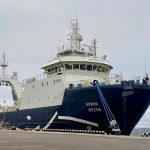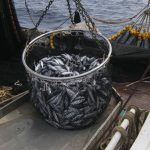The German submarine U864 was torpedoed and sank west of Fedje in 1945. The submarine may have had a cargo of 60-70 tons of mercury when it sank. The wreck lies at a depth of 150 meters and there is a concern that mercury from the cargo, probably spread during the explosion, may contaminate fish in this area. The National Institute of Nutrition and Seafood Research (NIFES) has determined the mercury levels of several species of fish and crab at and around the wreck annually from 2004-2008 in order to assess seafood safety and to monitor year-to-year changes of mercury.
– The new data shows that the mercury levels of tusk captured near U864 in 2008 are somewhat higher than previous years, but we can’t find that the levels are directly linked to the wreck, says senior scientist Amund Måge at NIFES.
– It is difficult to determine whether the mercury levels in fish caught near the wreck is elevated compared to background levels for this area, since there are hardly any data of the background levels of mercury from this region. The variation of mercury in seafood from the area over time may be random and cannot be taken as a proof of increased mercury levels nearby, although this may be the reason.
The Norwegian Food Safety Authority has previously given dietary advice concerning seafood from the region, where pregnant and breastfeeding women are recommended to avoid eating seafood from the area around the submarine. ’The Norwegian Food Safety Authority upholds dietary advice’ (from January 2008 only in Norwegian). Apart from this, the new analyses does not change the food safety situation in the area, says Måge. Higher levels of mercury in tusk for 2008 compared to previous years:
Tusk: Mercury levels in fillets of tusks caught in 2008 at the site of the wreck of U864, as well as two nautical miles north and four nautical miles south of the wreck, varied from 0,14 to 0,73 mg/kg wet weight. Twelve of the 75 tusks analysed showed a mercury concentration over EU’s maximumlimit of 0,5 mg/kg wet weight. Although more of the analysed fish had mercury concentrations over the limit than in previous years, the mercury levels are not considered to be especially high compared to levels found in tusk from presumably uncontaminated areas in Sunnmøre and the Norwegian Sea in 2007. Tusk caught at the wreck site had a lower mercury concentration compared to tusk caught further south and north, suggesting that there is no connection between contamination from the wreck and levels of mercury in fish from the area.








